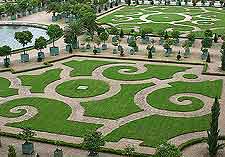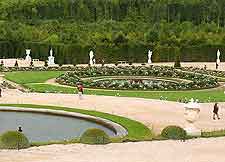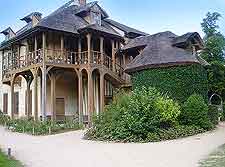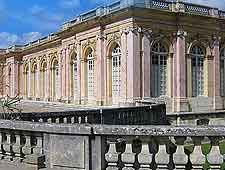Versailles History Facts and Timeline
(Versailles, Ile-de-France, France)

As a town, Versailles' history pre-dates its famous palace by several hundred years. Records first mention the town and estate of Versailles in 1038. By the end of the 11th century, a small village had grown up around the castle and church of Saint Julien.
During the Hundred Years War, however, many people left the village and it dwindled in size to just a handful of families. The royal origins of Versailles can only be said to begin during the 16th-century, when Louis XIII came here to hunt. He fell in love with the place and bought some land in the area. In 1622, he started work on building a small hunting lodge. During his reign, he went onto extend the lodge and buy more land.

A Royal Palace
Then, in the 1670s, the town's fortunes changed completely. Louis XIV began to take a real interest in Versailles. At this time, the French royal family lived in the Louvre Palace in
Paris. Louis XIV, better known as the Sun King, disliked the city with all its attendant political duplicity and uncertainty. He therefore chose to move his royal residence to Versailles.
Louis hired an architect, Louis Le Vau, who worked closely with Charles Le Brun, an artist. Together they designed the Baroque palace. The palace's formal gardens were the work of André Le Nôtre and were laid out in geometric patterns. Le Nôtre also created a large canal. To build the palace of Versailles it was necessary to clear many buildings in the town.
New planning regulations were also put into place so that future building work would not spoil the architectural beauty of the place. Roads were installed, along with sewers and lighting. Later, the palace was extended, until it was almost three times the size of the original building. Additions included the Hall of Mirrors, the Royal Opera, the Orangerie, the Royal Chapel and the Grand Trianon. From 1761, the Petit Trianon was built for Louis XIV and Madame de Pompadour.

Revolutionary Times in History
The French Revolution brought an end to royal life in Versailles. Its royal residents were abruptly removed to Paris under house arrest and were executed shortly afterwards. The collection of paintings and antiques housed here was also moved to Paris and many works were transferred to the Louvre. It is said that most of the furniture was auctioned off during this period.
In the 19th century, Versailles became popular with visiting noblemen, who must have wondered at the sheer extravagance of the palace and its grounds. Whilst in power, Napoleon spent many of his summers here. Then, in 1830, Louis-Phillipe decided to transform the palace into a grand museum rather than a royal residence. Many of the rooms were destroyed to make way for vast exhibition halls. The Royal Chapel, Opera and Hall of Mirrors were, however, preserved for posterity.

From the 19th Century to the Present Day
In more modern history, Versailles has been the venue for the signing of two treaties. In both cases, the Hall of Mirrors was chosen because it was large enough to accommodate the hundreds of officials involved in the treaty-signing process. The first took place in 1871 and marked the end of the France-Prussian War. A second Treaty of Versailles was signed in 1919, a year after the end of World War One.
In the 1960s, the curator Pierre Verlet attempted to restore many of the royal apartments back to their former glory. He managed to return some of the furnishings to their original surroundings. Today, Versailles is enjoyed by millions of tourists, who come to visit the palace's splendid interiors and magnificent gardens.
 As a town, Versailles' history pre-dates its famous palace by several hundred years. Records first mention the town and estate of Versailles in 1038. By the end of the 11th century, a small village had grown up around the castle and church of Saint Julien.
As a town, Versailles' history pre-dates its famous palace by several hundred years. Records first mention the town and estate of Versailles in 1038. By the end of the 11th century, a small village had grown up around the castle and church of Saint Julien.

